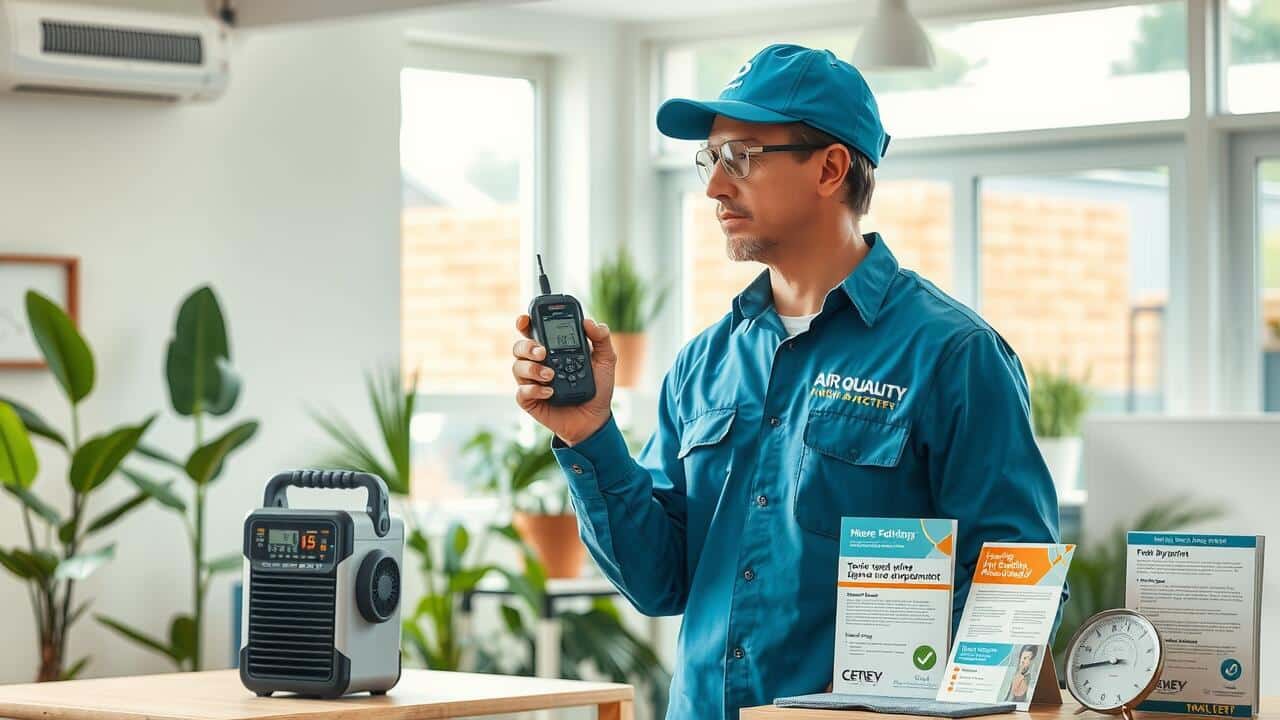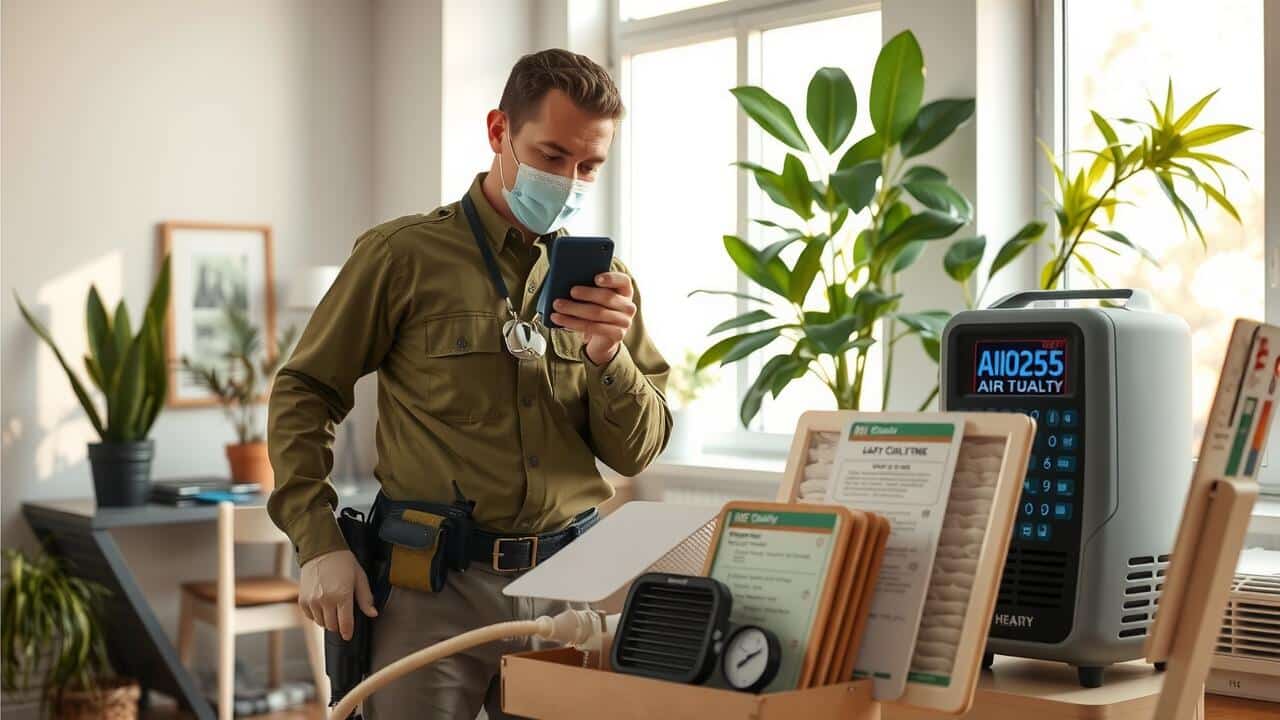
At One Step Air Duct Cleaning Dallas, we understand that indoor air quality is crucial for your health and comfort, which is why we specialize in comprehensive Indoor Air Quality Improvement services. Our expert team utilizes advanced techniques and state-of-the-art equipment to thoroughly clean and sanitize your air ducts, removing dust, allergens, mold, and other pollutants that can compromise the air you breathe. By enhancing the efficiency of your HVAC systems, we not only improve air quality but also help reduce energy costs and create a healthier living environment for you and your family. Trust One Step Air Duct Cleaning Dallas to ensure that every breath you take indoors is clean and fresh.
Steps to Control Indoor Air Pollution
Controlling indoor air pollution requires a multifaceted approach. Effective ventilation is crucial in reducing contaminants, as it helps to dilute indoor pollutants with fresh outdoor air. Opening windows and using exhaust fans can improve airflow, especially during cooking or cleaning activities that release chemicals or particles. Regular maintenance, such as replacing air filters in HVAC systems, plays a significant role in trapping allergens and other harmful substances. Utilizing air purifiers equipped with HEPA filters can further enhance indoor air quality by capturing smaller particulate matter like dust, smoke, and pollen.
Monitoring humidity levels is essential for preventing the growth of mold and other pathogens. Maintaining relative humidity between 30% and 50% can help reduce allergens while minimizing the likelihood of respiratory issues. In areas where mold is a concern, utilizing dehumidifiers can be beneficial. Additionally, being mindful of indoor pollutants from household products is important. Opting for low-VOC paints and cleaning supplies can significantly decrease the number of harmful emissions in the air. Regular cleaning of carpets, furniture, and other surfaces helps to reduce dust and other irritants that can affect overall health.
Practical Tips for Reducing Contaminants
Implementing practical measures can significantly reduce indoor air pollutants. Regular cleaning of air ducts helps eliminate buildup, ensuring that your HVAC system operates optimally. Opt for high-efficiency filters, such as those rated with MERV (Minimum Efficiency Reporting Value) standards, to trap smaller particles like dust mites and pet dander. Proper maintenance of heating systems is essential, as well as using a dehumidifier to control moisture levels that can encourage the growth of mold and dust mites.
Natural ventilation plays a crucial role in maintaining indoor air quality. Opening windows whenever weather permits can help reduce levels of indoor pollutants, including secondhand smoke and volatile organic compounds from building materials. It is also beneficial to keep your living space clean, focusing on areas that trap allergens such as carpets and pillows. Also, ensure that spaces like garages are well-ventilated to prevent the accumulation of fumes and pollutants that can enter your home.
The Role of Humidity in Indoor Air Quality
Humidity plays a crucial role in indoor air quality, affecting not just comfort but also health. When humidity levels are too high, mold and dust mites thrive, increasing the likelihood of asthma attacks and respiratory problems. Conversely, excessively low humidity can lead to dry skin, irritated respiratory tracts, and the worsening of thirdhand smoke symptoms. Maintaining optimal humidity levels between 30% and 50% is essential for mitigating these issues, as recommended by the Environmental Protection Agency.
Monitoring humidity is vital for overall well-being. Establishing a balance can enhance the quality of life by reducing the transmission of viruses and minimizing respiratory symptoms. Effective strategies such as using humidifiers or dehumidifiers help regulate moisture levels in the home. Houseplants can also contribute positively, as they naturally increase humidity and improve air quality. Regularly checking humidity with detectors can ensure that conditions remain within a healthy range, particularly in times of increased indoor activity or during a pandemic.
Effects of High and Low Humidity Levels
High humidity levels can create a breeding ground for mold growth and dust mites, both of which are common asthma triggers. Excess moisture in the air contributes to respiratory diseases by promoting the proliferation of airborne pathogens. Individuals exposed to high humidity may experience increased coughing and allergic reactions. Environments with high humidity also tend to have higher concentrations of volatile organic compounds (VOCs), which can exacerbate respiratory conditions like bronchitis.
In contrast, low humidity can lead to dry air that irritates the airways, causing discomfort and increasing susceptibility to infections. When humidity levels drop, the risk of airborne disease transmission rises, as respiratory droplets may remain suspended longer in dry air. Moreover, dry conditions can lead to problems like cracked skin and dry eyes, affecting overall reproductive health. Overall, maintaining a balanced humidity level is crucial for optimal indoor air quality and minimizing health risks linked to both extremes.
Upgrading Air Filtration Systems
Improving indoor air quality often starts with an effective air filtration system. Upgrading to high-efficiency particulate air (HEPA) filters can significantly reduce airborne particles like dust, pet dander, and mold spores. Utilizing these filters in an HVAC system can trap up to 99.97% of particulates that are 0.3 microns or larger. Regular maintenance, such as timely filter replacements, can ensure optimal performance and a reduction in allergens. It’s essential to consider the specific needs of your household, especially if there are individuals with respiratory conditions or allergies.
Another important factor in enhancing air filtration is the incorporation of ultraviolet (UV) lights. These systems can effectively eliminate viruses and bacteria, reducing the risk of airborne infections such as influenza and COVID-19. Considering the use of heat recovery ventilators can also provide fresh air while minimizing energy loss. With various options available, selecting the right filtration system should be based on the unique requirements of your living space and the health profiles of its occupants.
Choosing the Right Filters for Your Home
Selecting the appropriate air filters for your home is essential for maintaining a healthy indoor environment. High-efficiency particulate air (HEPA) filters are highly recommended due to their ability to capture a wide range of particles, including dust, pollen, and pet dander. Additionally, filters with activated carbon can help reduce odors and volatile organic compounds (VOCs), which are often found in household products like perfumes and cleaning agents. Ensuring the right filter size and type for your heating, ventilation, and air conditioning (HVAC) system boosts airflow while effectively trapping allergens and contaminants.
Regular maintenance of your air filters is crucial for optimal performance. Depending on your home environment and the presence of pets or smokers, filters should typically be replaced every one to three months. This not only improves air quality but can also enhance the efficiency of your HVAC system, ultimately leading to energy savings. Homeowners should consider the MERV (Minimum Efficiency Reporting Value) rating of filters, as higher ratings indicate better filtration capabilities. By making informed choices about air filters, you contribute to a healthier living space.
FAQS
What are some common sources of indoor air pollution?
Common sources of indoor air pollution include tobacco smoke, household cleaning products, mold, pet dander, dust mites, and volatile organic compounds (VOCs) emitted from paints, furniture, and building materials.
How can I reduce indoor air pollutants in my home?
You can reduce indoor air pollutants by ensuring proper ventilation, using air purifiers, minimizing the use of harsh chemicals, regularly cleaning and dusting, and keeping humidity levels in check.
What is the ideal indoor humidity level for good air quality?
The ideal indoor humidity level for maintaining good air quality is typically between 30% and 50%. This range helps prevent mold growth and reduces dust mites and other allergens.
How often should I change the filters in my air purification system?
It is generally recommended to change the filters in your air purification system every 1 to 3 months, depending on usage and the type of filter. Always refer to the manufacturer’s guidelines for specific recommendations.
What types of air filters are best for improving indoor air quality?
HEPA (High-Efficiency Particulate Air) filters are among the best options for improving indoor air quality, as they can capture 99.97% of airborne particles, including dust, pollen, and pet dander. Additionally, activated carbon filters can help reduce odors and VOCs.


